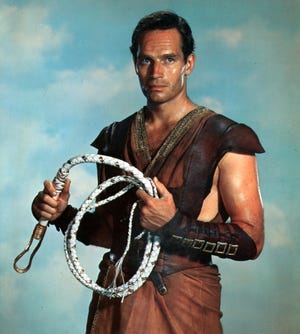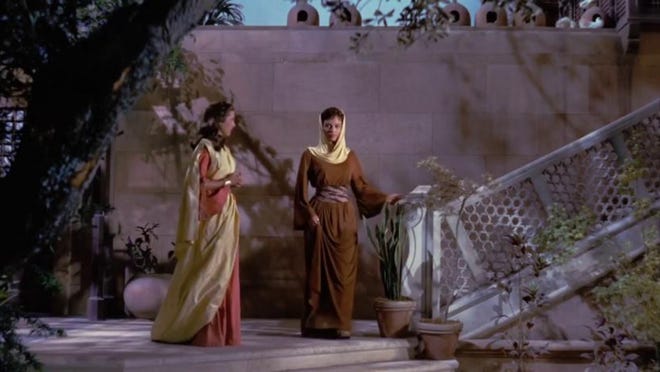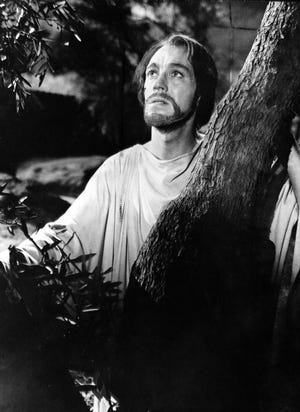
Here’s our list of Jesus movies to see
And the Lord said, “Let there be Light.”
He did not say “camera” and “action.” But Hollywood has never been slow to improve on an author — nowhere more so than in the films based on biblical subjects.
Whether it’s supplying Moses with a girlfriend (“The Ten Commandments,” 1956) or giving Samson lines like “Your arms were quicksand! Your kiss was death!” (“Samson and Delilah,” 1949), biblical blockbusters are proof, whatever the scriptures say, that is is possible to serve two masters: God, and the box office.
“When you look at a Cecil B. DeMille sword and sandal movie, you say, ‘Oh my God, it’s corny,’ ” said Nelson Page, executive director of the Barrymore Film Center in Fort Lee. “But it’s also incredibly impactful, and that’s why audiences came back, time and again.”
During the Easter season, movies about Jesus are liable to pop up on screens big and small. Page himself is showing one of the classics, “Ben Hur.” Or rather, two of the classics — since “Ben Hur” was box office gold on two occasions, in 1925 as a silent spectacular (2 p.m. Saturday, April 8) and in 1959 as an 11-Oscar-winning blockbuster (7 p.m. Saturday, April 8). For good measure, he’ll be showing “The Ten Commandments” at 7 p.m. Friday, April 7.

Jesus is, technically speaking, a walk-on in “Ben Hur” — in both films He is seen only fleetingly, as an outstretched hand, or from the back of a head. But make no mistake: He’s the real star of the show. General Lew Wallace subtitled his original book “A Tale of The Christ.”
“You don’t see Him, and to me that creates and accentuates the mystery of Christ on Earth,” Page said.
The more cynical — and the more devout — may scoff at all this Hollywood piety.
“It seems to be impossible for this Christian civilization to make a decent movie about the life of its founder,” wrote critic Dwight Macdonald in 1965. “All have been, as art or as religion, indecent.”
But much as the Hollywood versions of Jesus may deviate from scripture, it’s worth remembering that the Bible also has different versions of Jesus — and they deviate from each other. In Matthew, the baby Jesus is visited by three wise men. In Luke, he’s visited by shepherds. And that’s not to mention the apocrypha, the “gnostic” gospels, The Gospel of Thomas, The Secret Book of John. The movie moguls were following an old tradition.

What Hollywood can be blamed for is standardizing Jesus. The image of Christ — borrowed from medieval and Renaissance painting — as a blond, blue-eyed European is as demographically unlikely as it is, nowadays, culturally troubling.
“These large production companies understood who their audience was,” Page said. “And I think they played to the audience in terms of how they portrayed Jesus. You’re dealing with a middle class which was, in those days especially, a WASPy white audience. They were giving those audiences what they wanted, and what they expected to see.”
Jesus has been a movie star ever since D.W. Griffith’s “Intolerance” (1916) made him one of four interlocking stories of of man’s inhumanity to man. He’s been everything from a stern Marxist (Pasolini’s “The Gospel According to St. Matthew,” 1964) to a pop idol (“Jesus Christ Superstar,” 1973). He’s even been the star of his own miniseries — honorable mention here to “Jesus of Nazareth” (1977), one of the better dramatizations, though technically not a theatrical film.
Here, for Easter, are some of our favorite movie Messiahs.
‘Ben Hur’ (1925)
Jesus — here an outstretched hand — is just one of the attractions in this famous silent blockbuster. There are sea battles, a rather sickly early Technicolor, and of course the classic chariot race, one of the most justly famed of all action sequences. Even the remake didn’t top it.
‘King of Kings’ (1927)
This silent Cecil B. DeMille blockbuster, starring H.B. Warner (Mr. Gower in “It’s a Wonderful Life”) as Christ, set the standard for all future Jesus films — but it had a rough opening night.
DeMille, according to biographer Charles Higham, staged the premiere to end all premieres at Grauman’s Chinese Theater, complete with a live stage show featuring a biblical market scene with 100 extras, a boy soprano singing “The Holy City,” and a Daniel in the Lions’ Den tableaux with real (drugged) lions.
The film didn’t begin until 10 p.m., and by intermission — 2 a.m. — the audience began to stagger out en masse.
“H.B. Warner’s beard looked moth-eaten” and “Horrible Mary Magdalene,” they were heard to mutter. “Well, Cecil, there’s only one thing left now” said a sympathetic friend. “And that’s to get yourself run over on the way home.”
‘Ben Hur’ (1959)

Chariots, Charlton Heston and Jesus Christ — seen from the back. Stir well, and you get Hollywood gold — 11 Oscars worth. Our favorite biblical moment: the Star of Bethlehem, moving across the sky like an artificial satellite, finally settles above the manger in Bethlehem and then switches on its high beams — shining directly down onto the stable, so the Wise Men can find their way. Why not a neon sign?
‘King of Kings’ (1961)

Known in the trade as “I was a Teenage Jesus” for its casting of Jeffrey Hunter as a dreamy savior in red robes, this remake spends a lot of its time on the political struggles of first-century Judea, with Barabbas as a violent “revolutionary” opposite Jesus as a Gandhi-like peacemaker. Not quite chapter and verse — even if it is Orson Welles narrating.
‘The Gospel According to St. Matthew’ (1964)
Jesus — according to Italian director Pier Paolo Pasolini — was the greatest revolutionary of all time. Obviously, no Hollywood dreamboat could play Him. Che Guevara not being available (apparently, Pasolini did consider Jack Kerouac or Allen Ginsberg for the role), he settled for Enrique Irazoqui, a Spanish student whose non-actorish presence adds a welcome touch of believability.
This low-key film, a chip off the Italian neo-realist block, is more faithful to the Bible than any Hollywood Jesus movie (all the dialogue is directly from Matthew), but many people found Pasolini’s dour, severe Messiah hard to warm to.
‘The Greatest Story Ever Told’ (1965)

Audiences howled at this spectacle, which featured a distracting array of all-star walk-ons: Roddy McDowall, Sal Mineo, Angela Lansbury, Van Heflin, Charlton Heston, Richard Conte, and not least, Shelly Winters as The Woman Who is Healed (“Oy, I’m cured!”) and John Wayne as the Centurion (“Surely this was the Son of God” he drawls).
Shot in the American southwest — the actual Holy Land was not “real” enough for director George Stevens — the film was more like a Western in bathrobes. Somewhere amid all the buttes and mesas was Max Von Sydow. Under the circumstances, a dignified Jesus.
‘Jesus Christ Superstar’ (1973)
Ready for Jesus (Ted Neely) as a moody rock star? Audiences of the early ’70s were, even if the old guard objected (“It asks, not tells, who Jesus is,” Billy Graham complained). It was The Last Supper that set the table for Andrew Lloyd Webber’s fabulous career: cats and chandeliers were soon to follow. In all candor, this movie isn’t as fun as “Cats.” But what could be?
‘Godspell’ (1973)
One hippie Jesus not enough for you? Why not two? This one, derived from the Broadway show, was more a happy-go-lucky street clown.
‘The Last Temptation of Christ’ (1988)

The Pharisees whipping the savior had nothing on the crowds who savaged this Martin Scorsese film, which led to pickets at theaters and censorship at Blockbuster. At issue: Jesus (Willem Dafoe) as a guy with sex urges. Unthinkable. But not, apparently, unfilmable.
‘The Passion of the Christ’ (2004)

Americans are, traditionally, more comfortable with violence than sex. And this Mel Gibson blockbuster, with its beatings and scourgings and impalements in repulsive close-up, was a hit with some of the very same people who were offended by Scorsese’s film.
It upset a different group: Jews, who didn’t appreciate the film’s recycling of anti-Semitic tropes. Gibson, banished by Hollywood for a time, is now back and working on a sequel. Mazel Tov!
Go: “Ben Hur”: 1925 version, 2 p.m. Saturday, April 8; 1959 version, 7 p.m. Saturday, April 8; “The Ten Commandments,” 7 p.m. Friday, April 7, Barrymore Film Center, 153 Main St., Fort Lee; 551-215-0455, barrymorefilmcenter.com.
